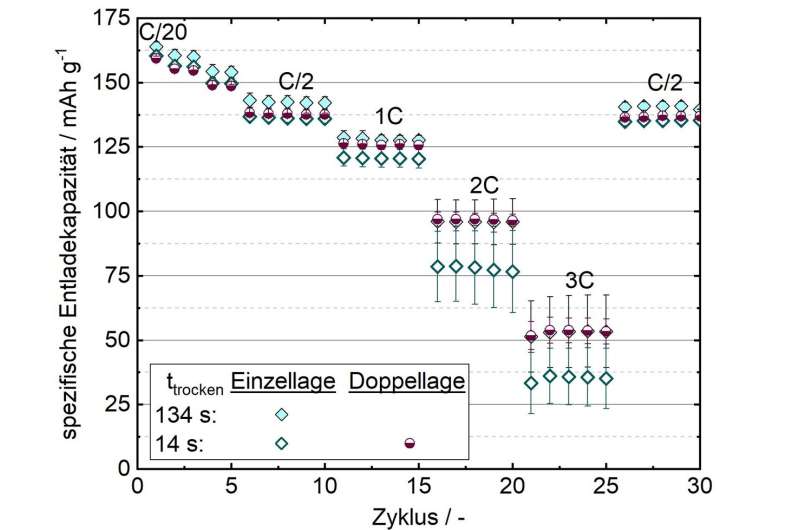Simultaneous coating and drying accelerates production of electrodes
Researchers of Karlsruhe Institute of Technology (KIT) have developed and successfully tested an innovative concept for simultaneous coating and drying of two-layered electrodes. Drying times can be reduced to less than 20 seconds, which corresponds to half down to one third of the usual production time, without capacity losses of the battery. With the help of the concept, lithium-ion batteries can be produced more rapidly and at lower cost. The results are reported in Energy Technology.
Electric vehicles will be of central importance to future mobility. This will result in a constantly growing demand for powerful and inexpensive batteries. In lithium-ion batteries, electrode layers are of decisive importance, as these active materials store the energy. However, coating and subsequent drying of electrodes cause most of the battery production costs. A big cost reduction potential lies in process engineering. Researchers of the Thin Film Technology (TFT) Group headed by Professor Wilhelm Schabel and Dr. Philip Scharfer have been conducting research in this area for years now. They already succeeded in considerably increasing coating speed and developed an innovative drying process. Now, the group has combined coating and drying in a simultaneous concept. The results are reported in Energy Technology, the main author being Jana Kumberg, doctoral researcher at KIT. TFT develops technologies for electrode production within CELEST—Center for Electrochemical Energy Storage Ulm & Karlsruhe, one of the biggest battery research platforms worldwide.
Cheaper production
“Our work shows that in principle, we manage all process steps needed to produce batteries more rapidly and, hence, at lower cost in future without affecting quality,” Schabel explains. At usual electrode drying times of up to one minute and production speeds of one hundred meters per minute and more, long drying lines are needed. In case of electrodes with a high coating weight, this is hardly feasible and very expensive. The new concept is based on the idea of using different active materials for the layers and applying them simultaneously. One layer is responsible for adhesion, another for specific capacity. This layer structure enables manufacture at a very high drying rate, drying times are shortened to one third.

Specific distribution of properties in the electrode layers
In spite of the reduced drying time, no capacity losses occur. The range of the battery remains the same, also in case of so-called 3C cycles i.e. rapid charging times of twenty minutes. Within their study, the scientists applied different active materials over the thickness of the anode, as a result of which different properties were distributed specifically in the electrode layers. In this way, electrodes can be customized and have better mechanical and electrochemical properties. “We have achieved first promising results,” Schabel says. “Now, we will work on industrial implementation.” At the moment, the group is working on ways to transfer the simultaneous concept to the industrial scale. For this purpose, it tests purely convective drying with high-performance nozzles and laser drying modules.
Studies are funded with more than EUR 5 million by the Federal Ministry of Education and Research (BMBF) within different research cluster projects. “Our research demonstrates that it may be possible in principle to increase battery production speed by two hundred to three hundred percent,” Schabel says. Now, the results are being transferred to other materials and used to optimize electrodes of sodium-ion batteries within the POLiS—Post Lithium Storage Cluster of Excellence.
Environmentally friendly manufacture of battery electrodes
Jana Kumberg et al, Reduced Drying Time of Anodes for Lithium‐Ion Batteries through Simultaneous Multilayer Coating, Energy Technology (2021). DOI: 10.1002/ente.202100367
Citation:
Simultaneous coating and drying accelerates production of electrodes (2021, November 12)
retrieved 12 November 2021
from https://techxplore.com/news/2021-11-simultaneous-coating-production-electrodes.html
This document is subject to copyright. Apart from any fair dealing for the purpose of private study or research, no
part may be reproduced without the written permission. The content is provided for information purposes only.
For all the latest Technology News Click Here
For the latest news and updates, follow us on Google News.

